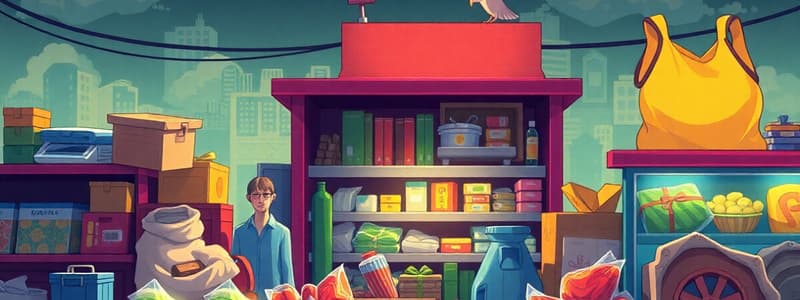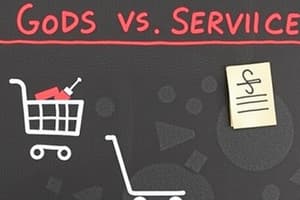Podcast
Questions and Answers
What characteristic of goods and services describes the inability to store certain items for later use?
What characteristic of goods and services describes the inability to store certain items for later use?
- Variability
- Perishability (correct)
- Inseparability
- Intangibility
Which of the following factors is most closely linked to a country's economic development?
Which of the following factors is most closely linked to a country's economic development?
- The number of vacations taken by citizens
- The geographical size of the country
- The average age of the population
- The types of goods and services produced (correct)
Which characteristic of services indicates that their value is difficult to evaluate before consumption?
Which characteristic of services indicates that their value is difficult to evaluate before consumption?
- Inseparability
- Variability
- Intangibility (correct)
- Heterogeneity
How does the balance between supply and demand affect the market?
How does the balance between supply and demand affect the market?
What describes the simultaneous occurrence of the production and consumption of services?
What describes the simultaneous occurrence of the production and consumption of services?
What is a key characteristic of durable goods?
What is a key characteristic of durable goods?
Which of the following is an example of a capital good?
Which of the following is an example of a capital good?
What distinguishes consumer services from business services?
What distinguishes consumer services from business services?
How does the relationship between goods and services enhance consumer experience?
How does the relationship between goods and services enhance consumer experience?
What is meant by the term 'intermediate goods'?
What is meant by the term 'intermediate goods'?
In developed economies, which trend is commonly observed regarding goods and services?
In developed economies, which trend is commonly observed regarding goods and services?
Which classification criterion separates goods from services?
Which classification criterion separates goods from services?
How do goods and services impact macroeconomic indicators such as GDP?
How do goods and services impact macroeconomic indicators such as GDP?
Which of the following is a service?
Which of the following is a service?
What characteristic differentiates durable goods from non-durable goods?
What characteristic differentiates durable goods from non-durable goods?
Which of the following best describes intermediate goods?
Which of the following best describes intermediate goods?
Which of the following statements about services is accurate?
Which of the following statements about services is accurate?
What does the term 'transferability' refer to in the context of goods and services?
What does the term 'transferability' refer to in the context of goods and services?
Why is scarcity a significant characteristic in determining the value of goods and services?
Why is scarcity a significant characteristic in determining the value of goods and services?
Which of the following types of goods are exemplified by food and fuel?
Which of the following types of goods are exemplified by food and fuel?
How do goods and services relate to a country's Gross Domestic Product (GDP)?
How do goods and services relate to a country's Gross Domestic Product (GDP)?
What distinguishes final goods from intermediate goods?
What distinguishes final goods from intermediate goods?
Flashcards
Durable Goods
Durable Goods
Goods expected to last a long time, like cars or appliances.
Non-durable Goods
Non-durable Goods
Goods used up quickly, like food or fuel.
Consumer Goods
Consumer Goods
Goods bought by individuals for personal use.
Capital Goods
Capital Goods
Signup and view all the flashcards
Consumer Services
Consumer Services
Signup and view all the flashcards
Business Services
Business Services
Signup and view all the flashcards
Tangibility (goods vs. services)
Tangibility (goods vs. services)
Signup and view all the flashcards
Goods and Service Relationship
Goods and Service Relationship
Signup and view all the flashcards
Economic Development
Economic Development
Signup and view all the flashcards
Supply and Demand
Supply and Demand
Signup and view all the flashcards
Heterogeneity (Goods/Services)
Heterogeneity (Goods/Services)
Signup and view all the flashcards
Perishability of Services
Perishability of Services
Signup and view all the flashcards
Market Equilibrium
Market Equilibrium
Signup and view all the flashcards
What are Goods?
What are Goods?
Signup and view all the flashcards
What are Services?
What are Services?
Signup and view all the flashcards
Durable vs. Non-durable Goods
Durable vs. Non-durable Goods
Signup and view all the flashcards
Intermediate vs. Final Goods
Intermediate vs. Final Goods
Signup and view all the flashcards
What is Utility?
What is Utility?
Signup and view all the flashcards
What is Scarcity?
What is Scarcity?
Signup and view all the flashcards
What is Transferability?
What is Transferability?
Signup and view all the flashcards
What is Standardization?
What is Standardization?
Signup and view all the flashcards
Study Notes
Goods and Services
- Goods are tangible items that can be seen, touched, and used. They are physical products offered for sale or consumption.
- Services are intangible activities offered for sale that satisfy customer wants or needs; they cannot be held, seen, or touched.
Types of Goods
- Durable Goods: These goods are expected to last a relatively long time, such as automobiles, furniture, or appliances. Durability is a key characteristic.
- Non-durable Goods: These goods are used up quickly. Examples include food, clothing, and fuel.
- Consumer Goods: Directly purchased by consumers for personal use.
- Capital Goods: Used in the production of other goods and services. Examples include machinery, tools, and factory buildings.
- Intermediate Goods: Used in the production of final goods or other intermediate goods.
Types of Services
- Consumer Services: Provided directly to consumers to meet their needs and wants. Examples include haircuts, education, and healthcare.
- Business Services: Provided to businesses to support their operations. Examples include accounting, legal services, and marketing.
The Relationship Between Goods and Services
- Goods and services are often sold together to provide a more comprehensive experience or solve a problem. Often a service relies on an accompanying good; a haircut service might need specialized scissors.
- In developed economies, the proportion of services in total economic output tends to increase as opposed to goods. This shift in the economy toward service-sector employment is a hallmark of economic development.
Classification Criteria
- Goods and services are categorized by various criteria including:
- Tangibility (physical vs. intangible): goods are tangible, and services are intangible.
- Durability (durable vs. non-durable): durable goods are lasting, non-durable are short-lived.
- End-use (consumer vs. capital): consumer goods are for personal use; capital goods are for supporting production.
The Significance of Goods and Services in Economics
- Goods and services are fundamental to an economy's functioning. They provide for basic needs and desires, driving production, consumption, and employment.
- The production and consumption of goods and services directly affect macroeconomic indicators such as GDP (Gross Domestic Product). The total output influences a country's economic strength and overall well-being.
- The amount, quality, and type of goods and services produced within a country reflects its particular stage of economic development. This includes the quality of its infrastructure, education and technology..
- Economic growth and development are deeply tied to the availability, affordability, and types of goods and services offered within a market.
- Changes in the demand for particular goods and services determine the amount produced. The responsiveness of supply and demand to price fluctuations will determine future production and consumption levels.
Characteristics of Goods and Services
- Heterogeneity: Products and services can demonstrate a wide range of differences in quality, features, and specifications. This heterogeneity is especially apparent in the service sector.
- Perishability: Certain goods and services can't be stored or delayed to address demand. For example, a barber's service at a certain appointment time is not available to anyone else.
- Intangibility: Most services lack physical characteristics. Their value and utility are more difficult to directly preview and evaluate.
- Inseparability: The production and consumption of many services occur simultaneously. Examples include haircuts and entertainment.
- Variability: Outputs from different service providers can differ significantly depending on the provider and circumstances. The reliability of a particular service can be variable.
Importance in Market Equilibrium
- The balance between supply and demand for goods and services is central to the determination of price.
Studying That Suits You
Use AI to generate personalized quizzes and flashcards to suit your learning preferences.




